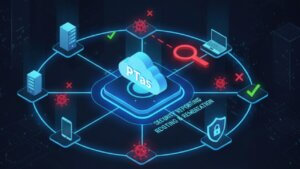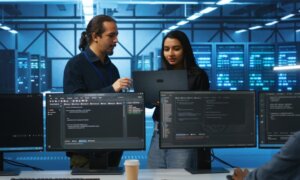The rise of cyber threats has brought botnets into the spotlight as one of the most powerful tools for executing large-scale Distributed Denial-of-Service (DDoS) attacks. Botnets—networks of compromised devices controlled by hackers—can generate overwhelming traffic to disrupt websites, servers, and online services. In recent years, botnet-driven DDoS attacks have targeted governments, financial institutions, and enterprises, causing significant financial and reputational damage.
In this article, we will explore what botnets are, how they operate, their role in DDoS attacks, and the best strategies for mitigation.
What is a Botnet?

A botnet (short for “robot network”) is a collection of internet-connected devices—including computers, servers, smartphones, and IoT devices—that have been infected with malware and are remotely controlled by a cybercriminal, often referred to as a botmaster or bot herder.
These infected devices, known as “bots” or “zombies,” can be used for various cybercrimes, including:
Spamming
Data theft
Spreading malware
Cryptojacking
DDoS attacks
How Do Botnets Work?
1. Infection and Recruitment
Botnets are typically created by infecting devices with malware. The infection process may involve:
-
Phishing Emails: Malicious attachments or links trick users into installing malware.
-
Exploiting Software Vulnerabilities: Hackers use exploits to gain control over unpatched devices.
-
Drive-By Downloads: Malicious websites install botnet malware without the user’s knowledge.
-
Compromised IoT Devices: Many IoT gadgets have weak security, making them easy targets.
Once infected, devices become “zombies” and communicate with the Command and Control (C2) server, which issues attack commands.
2. Command and Control (C2) Infrastructure
The C2 server allows cybercriminals to send commands to thousands or even millions of infected devices. Botnets use different C2 architectures, including:
-
Centralized (Single Server): A single point of control that sends commands to all bots.
-
Decentralized (Peer-to-Peer): Bots communicate with each other, making it harder to shut down.
-
Fast-Flux Networks: Frequently changing DNS records to evade detection.
3. Execution of Attacks
Once a botnet is ready, the attacker can execute DDoS attacks, overwhelming a target with excessive traffic. This can cause downtime, financial loss, and reputational damage.
The Role of Botnets in Large-Scale DDoS Attacks
Botnets are a key weapon for executing DDoS attacks, as they allow attackers to generate massive traffic volumes across multiple locations, making mitigation difficult.
Types of DDoS Attacks Using Botnets
1. Volumetric Attacks
These attacks flood the target with excessive traffic, exhausting bandwidth and disrupting services.
UDP Floods: Send large numbers of UDP packets to overwhelm network resources.
DNS Amplification: Exploits open DNS resolvers to amplify attack traffic.
NTP Amplification: Uses Network Time Protocol servers to generate high-bandwidth traffic.
2. Protocol-Based Attacks
These attacks exploit weaknesses in network protocols to consume server resources.
SYN Floods: Overload the TCP handshake process, making servers unresponsive.
ACK Floods: Send numerous ACK packets, forcing servers to use up resources.
Smurf Attacks: Send ICMP requests with a spoofed IP, causing multiple devices to flood the target with responses.
3. Application-Layer (Layer 7) Attacks
Botnets also execute Layer 7 DDoS attacks, which target web applications rather than network infrastructure.
HTTP Floods: Bombard a website with HTTP GET/POST requests to overload its processing power.
Slowloris Attacks: Keep connections open for an extended period, preventing legitimate users from accessing the website.
Botnet Scrapers: Use botnets to scrape website content at an excessive rate, causing slowdowns.
Notorious Botnets Used for DDoS Attacks
1. Mirai
One of the most infamous botnets, Mirai exploited IoT devices with default passwords, launching some of the largest DDoS attacks in history.
2. Mēris
Mēris targeted financial institutions using high-bandwidth attacks, reaching traffic spikes of over 21 million requests per second.
3. Reaper
A sophisticated botnet that targeted IoT devices by exploiting software vulnerabilities instead of relying on default passwords.
4. Mozi
A peer-to-peer (P2P) botnet that infected routers and IoT devices to carry out large-scale DDoS attacks.
1. Early Detection of Botnet Activity
Organizations must monitor network traffic for signs of botnet-driven attacks. Key indicators include:
Unusual Traffic Spikes: A sudden increase in incoming requests.
Geographically Distributed Attacks: Traffic originating from multiple locations.
Unusual Protocol Usage: High levels of SYN, UDP, or ICMP requests.
Repeated Failed Logins: Indicators of botnet-driven brute-force attempts.
2. Implementing DDoS Protection Solutions
Mitigation strategies include:
Cloud-Based DDoS Protection: Services like Cloudflare, AWS Shield, Akamai, and Imperva help absorb attack traffic.
Rate Limiting: Restricting the number of requests from a single IP to prevent volumetric attacks.
Web Application Firewalls (WAFs): Filters malicious Layer 7 traffic.
Intrusion Prevention Systems (IPS): Detect and block malicious network traffic.
3. Strengthening IoT Security
Since many botnets exploit IoT devices, businesses must:
Change Default Passwords: Prevent easy access to IoT devices.
Regularly Update Firmware: Patch vulnerabilities to reduce attack surfaces.
Disable Unnecessary Services: Reduce exposure to attacks.
4. Using AI and Machine Learning for Threat Detection
Modern cybersecurity solutions leverage AI-driven analysis to detect and respond to botnet activity in real time.
5. Collaboration and Threat Intelligence Sharing
Organizations should collaborate with cybersecurity agencies, ISPs, and cloud providers to share intelligence and counter emerging botnet threats.
Conclusion
Botnets remain a critical enabler of large-scale DDoS attacks, capable of overwhelming even the most resilient networks. As cybercriminals continue evolving their attack strategies, businesses and governments must adopt advanced detection, prevention, and mitigation techniques.
By implementing robust DDoS protection, strengthening IoT security, and leveraging AI-powered defense mechanisms, organizations can significantly reduce the impact of botnet-driven cyber threats. Staying proactive and continuously improving security measures is the key to ensuring a resilient digital infrastructure in 2025 and beyond.
Why Businesses Trust SecureMyOrg For Comprehensive Network Security
At SecureMyOrg, we uncover and fix all possible security vulnerabilities of mobile and web, while providing solutions to mitigate risks. We are trusted by renowned companies like Yahoo, Gojek and Rippling, and with 100% client satisfaction, you’re in safe hands!







Some of the things people reach out to us for –
- Building their cybersecurity program from scratch – setting up cloud security using cost-effective tools, SIEM for alert monitoring, building policies for the company
- Vulnerability Assessment and Penetration Testing ( VAPT ) – We have certified professionals, with certifications like OSCP, CREST – CPSA & CRT, CKA and CKS
- DevSecOps consulting
- Red Teaming activity
- Regular security audits, before product release
- Full time security engineers.
Relevant Posts

AI-Powered Phishing Emails: 7 Ways to Spot and Stop Them Before They Strike
Penetration testing as a service (PTaaS) lets experts simulate real attacks to uncover vulnerabilities before hackers do. This guide explains the process, benefits, and costs, helping businesses strengthen defenses with predictable, ongoing security checks.

Why Regular Penetration Testing is Essential for Modern Companies
Penetration testing as a service (PTaaS) lets experts simulate real attacks to uncover vulnerabilities before hackers do. This guide explains the process, benefits, and costs, helping businesses strengthen defenses with predictable, ongoing security checks.

What Is Penetration Testing as a Service?
Penetration testing as a service (PTaaS) lets experts simulate real attacks to uncover vulnerabilities before hackers do. This guide explains the process, benefits, and costs, helping businesses strengthen defenses with predictable, ongoing security checks.

How To Inspect Encrypted Traffic Without Breaking Privacy
Network administrators face a challenge: securing systems while respecting privacy. This guide explains how to inspect encrypted traffic without breaking privacy using metadata, anomaly detection, and machine learning ensuring visibility, compliance, and trust.

How to Audit Infrastructure as Code (IaC) for Security Vulnerabilities
Discover how to audit Infrastructure as Code (IaC) for security vulnerabilities with this practical guide. Learn to scan IaC files using tools like Checkov, fix issues like exposed resources, and integrate audits into CI/CD pipelines. Protect your cloud systems from misconfigurations and ensure compliance with clear, actionable steps.

DevSecOps Best Practices: Integrating Security Early in Your CI/CD Pipeline
This article provides a practical guide to embedding security into every stage of your CI/CD pipeline. Learn core DevSecOps best practices like SAST, DAST, dependency scanning, secrets management, and compliance automation to catch vulnerabilities early, foster a culture of shared ownership, and build a secure-by-design development process that accelerates release cycles.
